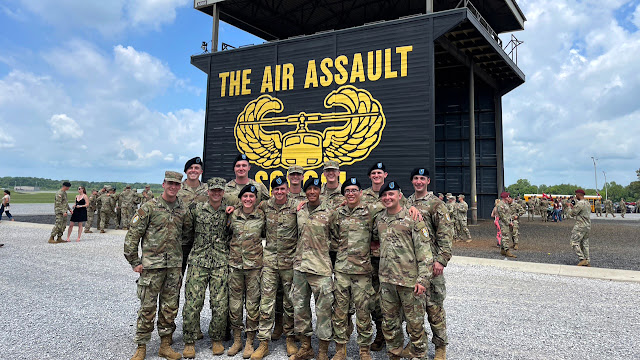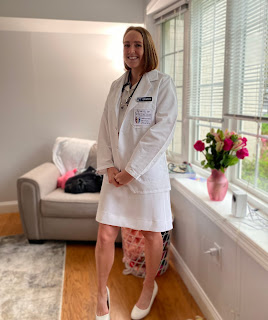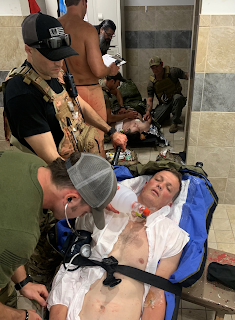Learning the Ropes: How USU Medical Students Spent Their Summer Operational Experiences
By Ian Neligh
From the legendary United States Army Air Assault School to training with the elite Navy SEALS, students from the Uniformed Services University of the Health Sciences (USU) took part in a host of summer experiences as they prepared for their second year of medical school.
The Summer Operational Experience, sponsored by the Office of the Professor of Military Science with USU’s Griffith Institute in conjunction with the USU Brigade, is an opportunity for students to select training from a list of options, or in some cases created specially for them, during their seven-week summer between educational years.
Army 2nd Lt. Carl Failing
The competition is stiff for those looking to attend the Army’s Air Assault School (officially called the Sabalauski Air Assault School) at Fort Campbell, Kentucky. There, students learn to rappel from a helicopter and make the most of helicopter assets to support their unit operations. Those who graduate from the school earn the prestigious Air Assault badge.
“All students submit a ranked preference for which summer operational experience they wish to do, and some have associated prerequisites,” says Army 2nd Lt. Carl Failing, who spent his summer at the school. “Because of the physical demands of Air Assault School, and the limited number of slots, an order of merit list was made based on students’ ruck times, run times, and Army Combat Fitness Test score.”
He says those ranked among the highest then completed a six-week “train-up” to demonstrate adequate preparation before they were finally chosen for the school.
“Southern Kentucky is brutally hot in July, and Air Assault School involves lots of physical activity outdoors,” Failing says. “While uncomfortable, the other USU students and I learned how to adapt to a new training environment.”
Failing says the experience gave him a glimpse into the lives and jobs of those future patients, the warfighters, he’s in medical school learning to serve and it also helped lay the foundation to be a more empathetic physician later in his career.
“The culmination of the Air Assault course is rappelling out of a hovering Blackhawk helicopter which is, without question, the coolest thing I have ever had the opportunity to try,” Failing says of his favorite moment from the training. “Before having that opportunity, however, the physical hurdles we completed - running, rucking, ‘PTing,’ and doing an obstacle course in the heat — was challenging.”
Navy Ensign Andrea Sparks
Navy Ensign Andrea Sparks says she designed her own summer experience because of what she sees as a need for
those in the Navy to better understand the Marines they’ll be providing healthcare for.
“The Marine Corps doesn’t have any embedded healthcare; they don’t have doctors or anything like that — so the Navy provides all the healthcare for the Marines,” says Sparks. “… So I created this experience to learn about the Navy/Marine Corps relationship with a medical lens.”
Sparks says she believes it is especially important for Navy medical school students to learn about the Marine Corps to become more fully rounded.
“(And) to understand a huge part of our job is to care for Marines,” Sparks says. “When I first set up this experience, I told them I was being taught medicine from USU — but I still needed to learn how to lead Marines so that I can be the best provider.”
During the summer she received assignments to learn about important language and terminology in the Marine Corps as well as the opportunity to sit in on high-level meetings.
“These opportunities that they gave me were so wonderful,” Sparks says.
She says the experience was better than she anticipated and was even encouraged to create a Marine Corps student interest group at the university.
Navy Ensign Colin McCarty
Navy Ensign Colin McCarty chose to go to the Naval Special Warfare Command in San Diego, Calif., so that he could learn more about military operations directly relevant to his branch and future career.
“I always want to take advantage of any rare opportunity that I would be unlikely to have at any other time in my career,” McCarty says. “Not many doctors ever have the chance to learn how SEALs are trained and maintained as a fighting force—let alone the chance to learn a small amount of operational skills directly from them.”
McCarty says he spent the first week focused on operational training and skills such as rifle marksmanship, basic hand-to-hand combat, patrolling under night-vision goggles, and traversing obstacle courses. The second week focused on special forces medicine, as he shadowed in the base clinic for candidates’ daily medical checks during the infamous “Hell Week”.
“The experience was incredible,” McCarty says. “… We also had the privilege of discussing emergency medicine best practices and career pathways in operational medicine with SEAL combat medics and Underwater Medical Officer or Fleet Marine Force-qualified physicians. Overall, we learned firsthand what it takes to become a SEAL, and what it takes to make sure that those sailors are properly cared for—both at home and on the battlefield.”
He says he enjoyed attempting the obstacle course and water obstacle course during his first few days.
“After my first year of medical school with all of its higher-order problem solving and patient diagnostics, it was refreshing to encounter challenges of ‘send your body over these logs, hooyah,’” McCarty says. “The experience of trying my hand at these obstacles also helped expand my appreciation for the SEALs and SEAL candidates, any of whom could run laps around me.”
McCarty adds the experience was extremely helpful in adding context to his medical training.
“As future military physicians, we are expected to provide competent care both in the hospital and on the battlefield; but while we are able to rotate through military hospitals around the country, we can’t exactly rotate on the front lines,” McCarty says. “Instead, the Department of Military and Emergency Medicine does an excellent job of integrating their tactical-care-focused curriculum throughout our four years, and I believe the Summer Operational Experience is a critical part of that curriculum by sending us out to be totally immersed in an operational environment.”
U.S. Public Health Service Ensign Jackson Storm
U.S. Public Health Service Ensign Jackson Storm’s summer experience in Oklahoma was organized by the Indian Health Service (IHS). The state is in one of 12 service areas for the IHS, which is sponsoring Storm’s education at USU.
“I think in many ways it gave me a good idea of what our medical career will look like in IHS,” Storms says. “We got to learn more broadly what the IHS does; it’s not just clinical services, they also provide water field engineer services, dental services — many other things besides just medical service that people think of.”
Storm says it was a good shadowing experience for him where he spent time with leadership and learned what the day-to-day responsibilities looked like for a health administrator and those in clinical leadership.
During his summer experience, Storm shadowed a surgeon and spent some time in a primary care clinic. Storm and fellow PHS student, Ensign Apurva Chavali, also had the pleasure of attending a Comanche tribal powwow. There the students watched another PHS officer, a member of the Comanche tribe, lead dances. Storm says they were even invited to share dinner with the officer’s family.
Storm adds that experiences outside of the clinic were just as important as those inside of it.
“So it was a very broad, eclectic number of activities that we got to do,” Storm says, adding that one of the biggest things he learned was how important it is for a good physician to listen to their patients and try to understand where they’re coming from.
“Getting to hear that confirmed was an encouraging thing.”
Army 2nd Lt. Brent Bubany says with his Army Special Forces background he knew he wanted to train with the Joint Special Operations Medical Training Center at Ft. Bragg, N.C., which runs two-week Special Forces Medical Sergeant Skills Sustainment Courses (SOCMSSC) year-round.
“It was a great training experience that met and exceeded my expectations,” Bubany says, adding SOCMSSC gives USU medical students an up close and better understanding of the capabilities of special forces medics.
“The things I enjoyed most in the training were seeing the special forces medics’ capabilities in action, the high quality of the instruction and simulations during the trauma lanes,” Bubany adds. “I loved learning new tips and tricks — efficiencies for doing the procedures. And I got great instruction, not only from the cadre but also from my classmates who are not only great practitioners but also great teachers.”
Navy Ensign Aneka Patterson
When looking at the different options for the summer operational opportunities, Navy Ensign Aneka Patterson says she believed a shipboard experience on the USS Anchorage would provide her with a chance to gain insight into daily life on a ship and medical care capabilities while underway.
“This seemed like a great opportunity to grow as both a naval officer and as a future provider in the Military Healthcare System,” Patterson says. “Myself and the other medical students had the opportunity to speak to so many different people about what they do and what life is like for them on the ship.”
Patterson says she and other USU students were able to learn about the medical capabilities available while a ship is underway, the kinds of operational activities the ship can support, and the general flow of day-to-day life while aboard.
“During this experience, there was a nice balance between time spent in the medical area and time spent learning about the ship, operational exercises, and general lives of the Sailors and Marines aboard,” Patterson says. “I learned about what care can look like in an operational environment, and how I can better support the mission and our personnel as a medical officer.”
Patterson added her interactions with the others aboard the ship made up the best of many great experiences.
“I am immensely grateful to the physicians and corpsmen serving with the USS Anchorage and the embarked Marines for helping our group of medical students integrate into daily life while underway,” Patterson says. “We were also able to meet so many awesome people from other fields outside of medicine who taught us about their roles aboard the ship. Hearing the Sailors and Marines share their experiences and their work with us was really motivating.”









